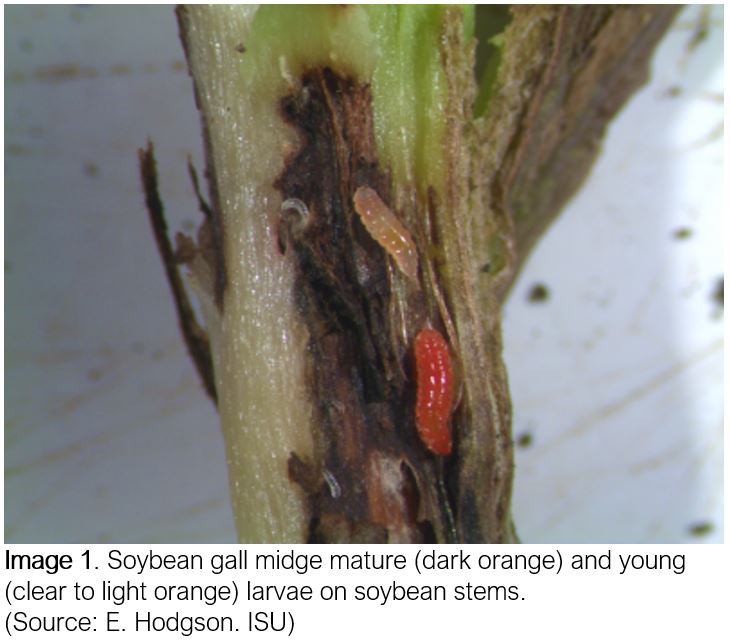
- Since its first isolated reports in Nebraska in 2011, the soybean gall midge is now present in 66 counties in the states of Nebraska, Iowa, South Dakota and Minnesota.
- In 2018, some fields exhibited severe damage and stand losses.
- Feeding damage appears to be worse on field edges and decreases towards the inside of the field.
- Because so little is known about this pest, researchers in states affected by the soybean gall midge continue to study its biology and effective ways to manage it.
The soybean gall midge (SGM) is an emerging pest of soybeans in parts of the Midwest, being first reported in Nebraska in 2011. Since then, the presence of the SGM continued to expand and to date, this pest has been confirmed in 66 counties across Nebraska, South Dakota, Iowa and Minnesota. Initial reports were isolated and typically associated with fields where hail damage or other fungal pathogens were present. In 2018 some fields exhibited severe damage with significant stand and yield losses. Growers in these affected areas are desperate for a solution and concerned for the 2019 growing season, as no effective options are available yet.
PEST DESCRIPTION AND DAMAGE
The soybean gall midge (Order Diptera, Family Cecidomyiidae) has been identified as a new species in the genus Resseliella; R. maxima. The larval (maggot) stage is legless, orange in color when mature, while young larvae are clear to white and smaller in size (Image 1, above right). The adults are about ¼” long, slender, with an orange abdomen and long legs showing a white and black banding on them. Several maggots can be found in one soybean stem at once. Symptoms of damage to soybeans include dark discoloration or swollen stems at the soil surface and these stems may easily snap off. The outer layers of the stem can be peeled back and reveal the clear to orange colored larvae feeding on the stem. In 2018, heavily damaged fields had high numbers of dead plants on the field edges while plant mortality decreased towards the inside of the field. Data from Nebraska, on a small-scale sample, indicated up to 100% yield loss in the first 100 ft from the field edge in and about 20% yield loss 200 and 400 ft from the field edge. High numbers of dead plants will negatively affect yields and even when plants survive, weakened stems are more prone to lodging. Aboveground symptoms could be misdiagnosed as seedling pathogens (Phytophthora or Pythium) especially if the weather and soil conditions are ideal for disease development. However, if the SGM is the cause, closer examination of the stems should reveal the presence of the larvae. Sometimes you may have a combination of things and sending samples to a diagnostic clinic will be the best way to know for sure what factor or combination of factors you may be dealing with.
WHAT WE KNOW SO FAR
Researchers in states affected by the SGM have gathered as much information as possible and continue to study this pest, its biology and effective ways to manage it. Observations from 2018 provided more information about the feeding and overwintering behavior of the SGM and the adult stage was identified for the first time in the fall of 2018. Feeding damage was worse on the edges of the field and decreased towards the inside of the field. Often, these heavily damaged areas neighbored fields that were planted to soybeans the previous year which suggests that this pest may overwinter in those affected fields. There are potentially a few overlapping generations of the SGM in one growing season and based on the varying colors and sizes of the larvae, there is probably an extended egg-laying period by the females.
HOW ABOUT CHEMICAL CONTROLS?
Contact insecticides will not provide control of the larvae as they are “protected” from coming into contact with the chemical once inside the stem. High rates of seed treatments and systemic insecticides may be looked at in University trials this coming season. Currently, Endigo®ZC has a 2(ee) label for suppression of SGM adults in NE, IA and SD. However, no University efficacy data is available to support this recommendation yet.
Stay tuned for more information on soybean gall midge management in the 2019 season. If the presence of SGM is noted in new fields and counties where they have not been previously reported, make sure to contact your local extension entomologist.
Sources:
Justin McMechan. Soybean Gall Midge. Cropwatch publications 2018-2019. University of Nebraska-Lincoln.
Erin Hodgson. Soybean gall midge: A new field crop pest. 2018. Iowa State University.